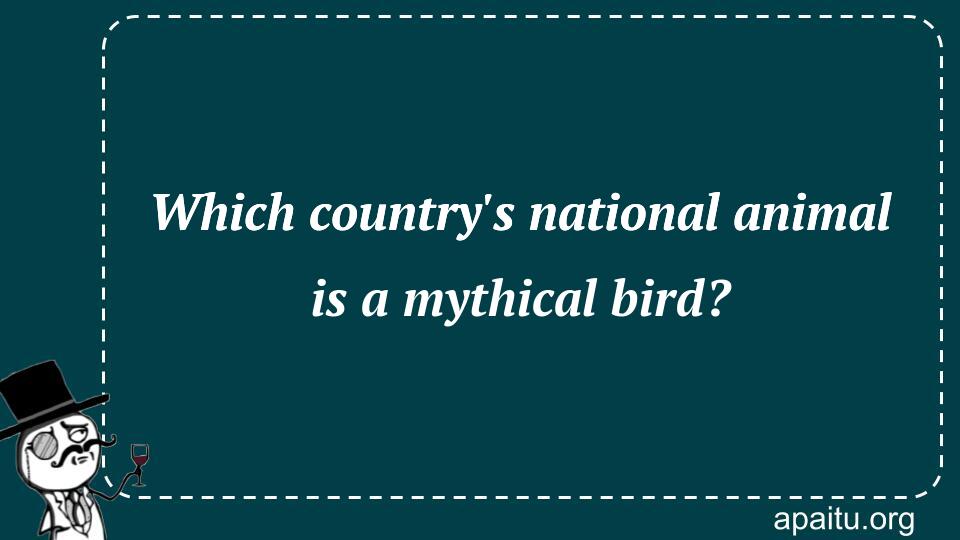Question
Here is the question : WHICH COUNTRY’S NATIONAL ANIMAL IS A MYTHICAL BIRD?
Option
Here is the option for the question :
- Turkey
- Greece
- Bhutan
- Hungary
The Answer:
And, the answer for the the question is :
Explanation:
Scotland’s national animal is a unicorn, so who says a mythical bird can’t join the mix? Hungary’s official national animal is the Turul, which is not a real mammal. The Turul, according to tradition, was a celestial messenger who resided in the Tree of Life’s branches. Princess Emese received a prophecy from the Turul that she would give birth to a line of legendary kings as part of one of their prophetic messages. The Turul appeared once more to assist a tribal chief from Hungary who was under attack from eagles who were encircling the tribe’s horses. (And, of course, the fabled bird triumphed.) There are countless statues all around the nation that feature the Turul, who are typically portrayed as hawk- or falcon-like birds.

Greetings, curious readers, and welcome to a captivating exploration of national symbolism and mythical creatures. Today, we set our sights on the enchanting country of Hungary, where a mythical bird soars proudly as the national animal. Join me as we unravel the intriguing story behind Hungary’s national symbol and discover the significance of this majestic creature in the nation’s rich cultural heritage.
Hungary, nestled in the heart of Central Europe, is a land steeped in history, folklore, and ancient traditions. The nation’s national animal, the mythical bird known as the Turul, holds a special place in the hearts of Hungarians and embodies the spirit of their heritage. The Turul is a legendary bird of prey, revered for its strength, grace, and mythical attributes.
In Hungarian mythology, the Turul is believed to be a divine messenger and a guardian spirit. It is often depicted as a large, hawk-like bird with a wingspan stretching several meters. Legend has it that the Turul played a significant role in the origin story of the Hungarian people. According to folklore, the bird appeared to Emese, the mother of Árpád, the founder of the Hungarian nation, in a dream, foretelling the birth of a great leader.
The Turul’s association with Hungary’s national identity can be traced back to the time of the Magyar tribes, who settled in the Carpathian Basin in the 9th century. The Magyars, the ancestors of modern-day Hungarians, regarded the Turul as a sacred creature and a symbol of power, nobility, and freedom. It served as a unifying emblem, representing the unity and resilience of the Hungarian people.
Throughout Hungarian history, the Turul has been a recurring motif in art, literature, and national symbolism. It has graced the country’s coat of arms, adorned architectural structures, and been depicted in various forms of traditional artwork. The image of the Turul soaring through the sky resonates deeply with Hungarians, evoking a sense of pride, identity, and connection to their ancestral roots.
The Turul’s symbolism extends beyond its mythical origins. It represents the spirit of independence and the enduring strength of the Hungarian people. During times of struggle and oppression, the image of the Turul served as a source of inspiration and a rallying symbol for national unity. It embodied the resilience and determination of the Hungarian nation to overcome challenges and preserve their cultural heritage.
In contemporary Hungary, the Turul continues to hold a significant place in the national consciousness. It serves as a powerful reminder of the country’s rich history, its enduring traditions, and the unwavering spirit of its people. The Turul embodies the values of freedom, strength, and aspiration, encapsulating the essence of the Hungarian identity.
The presence of the Turul can be felt throughout Hungary, from the iconic statues and sculptures gracing public spaces to the traditional folklore passed down through generations. It is a reminder of the deep-rooted connection between the Hungarian people and their mythical heritage. The Turul’s majestic presence serves as a unifying force, transcending time and connecting Hungarians across generations.
As you immerse yourself in the vibrant culture and breathtaking landscapes of Hungary, take a moment to appreciate the significance of the Turul. Let the mythical bird guide you through the nation’s storied past and inspire you to explore the depths of its rich heritage. Discover the spirit of the Turul within yourself—a symbol of resilience, freedom, and the power of dreams.
Hungary’s national animal, the mythical Turul, represents more than just a creature of folklore. It embodies the indomitable spirit of the Hungarian people, their connection to their ancestral roots, and the values they hold dear. So, as you wander through the historic streets of Budapest or traverse the picturesque Hungarian countryside, remember the majesty of the Turul and the enduring legacy it represents—a testament to the strength, pride, and unity of Hungary and its people.